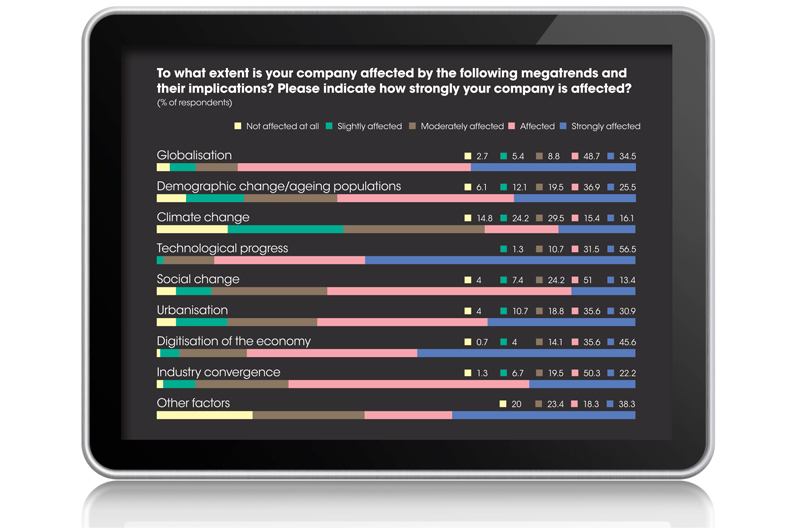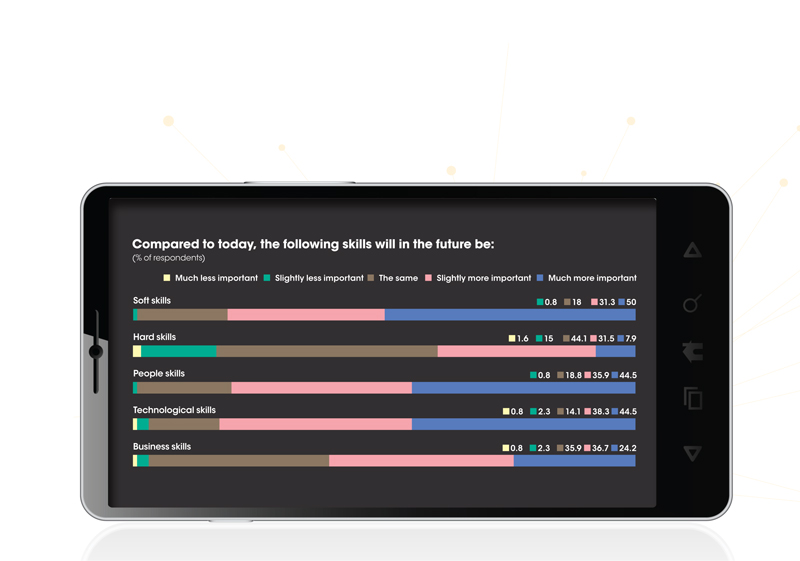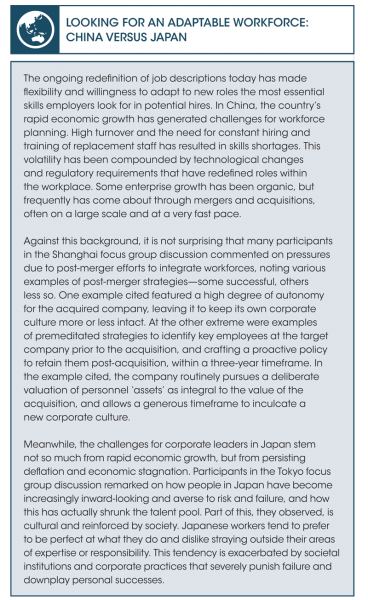Companies need to ensure that they are ready to embrace disruptions and fend off potential skills gaps and talent shortages.
Skills are the essential resource in the knowledge economy of the 21st century. With the unprecedented economic developments in Asia and the dramatic changes rattling through many industries, managing the business responses to these changes and developing the organisation’s human capital to equip employees with the skills needed in this environment is becoming a key challenge for businesses. The skills required are likely to comprise both soft and hard skills, that is, people skills, technological skills and business skills. At the same time, to be successful and sustainable, the responses need to be sensitive to the cultural and organisational realities of the Asian business environment.
Tomorrow’s markets will be more complex. To thrive in this environment, businesses should be able to develop the ability to attract, develop and retain the best talent available to them.
Megachanges await us
Megatrends and the ‘megachanges’ they trigger have become more and more important—and are increasingly recognised as having a tremendous impact on societies, economies and businesses.1 These megatrends comprise various social, economic, demographic and technological changes. Of these, the eight ‘mega-important megatrends’ are globalisation, demographic change/ageing populations, climate change, technological progress, social change, urbanisation, digitization of the economy, and industry convergence. Managers all across Asia are becoming more sensitive towards these developments and, as a result, are looking for the relevant business intelligence to make sense of them.
A 2016 report from the Economist Corporate Network (ECN) examines how Asian CEOs perceive the challenges and opportunities that arise from these megatrends in terms of the organisation’s skills and talent management, and explores the extent to which they are taking ownership of developing the skills that will be required in future and ‘skilling-up’ their workforce.2 According to the report, more than 70 percent of executives surveyed presently spend more time identifying megatrends than they used to. A staggering 85 percent of them also spend more time thinking about the kind of skills their businesses will need in order to deal with these megatrends.
Megatech
Technological progress seems to accelerate at unprecedented speeds. Self-driving cars, three-dimensional printing, next-generation robots and artificial intelligence are at the cusp of establishing themselves in the business world and society at large.3 This offers business opportunities, but also creates risks for companies and their workforce. According to some estimates, five million jobs will be lost by 2020 as technology renders human work redundant in some areas,4 especially single-skillset jobs.5
To retain their place in the labour force, individuals have to acquire skills that match the socio-technological changes in the work environment. Companies thus have to retrain and reskill workers to avoid a crisis situation.6 Technological changes require a workforce that is able to keep up with these developments. At the same time, they also challenge the workforce to surpass technological progress time and again in order to not be replaced by them. For this innovation of work, new and adapted skills are of fundamental importance.

Unpredictable
Complexities stemming from megatrends such as industry convergence, technological change and globalisation pose new challenges for managing businesses. A more unpredictable and complex social and business world requires more qualified workers who can adapt to a variety of situations and challenges. The challenges brought on by megatrends have, thus, long since reached companies and come to the attention of senior executives. While there is a certain level of awareness and understanding of the business implications of megatrends, plenty still needs to be done to ensure executives have the relevant business intelligence to interpret megatrends in a meaningful way and acquire the talent that can thrive in a changing marketplace.
Of the eight major megatrends surveyed, executives assign the most importance to changes stemming from globalisation, technological progress and digitisation of the economy. Over 80 percent of the senior executives surveyed think that the abovementioned trends affect or strongly affect their companies. Among these, technological progress is seen as the most important trend, with 56.5 percent of CEOs stating that it strongly affects their company.
Only a small number of CEOs are confident that their company is completely prepared to deal with these trends. While urbanisation, globalisation and technological progress are among the megatrends that CEOs are most prepared for, they feel significantly less prepared for trends such as industry convergence and climate change. These are, in fact, perceived to be threats rather than opportunities to get ahead of the competition.
Skills 4.0: Mind the gap
A staggering 90 percent of the senior executives are confident that they know which skills are required to respond to global megatrends. This seems promising but does not guarantee that companies actually have these skills already in their workforce. Indeed, about 58 percent of CEOs believe that most of the skills required for their business to respond to global megatrends are new skills that they neither appreciate nor use today.
There is some regional variance to this. While 61 percent of the respondents in China agree that the skills needed in the future are new, only 48 percent in Singapore agree. In Japan, only one third of the CEOs believe this is so, with 47 percent disagreeing (the rest are unsure). This could be interpreted in two ways. On the one hand, these supposedly new skills might already be familiar to respondents in Japan—regardless of these megatrends. This might have to do with the Japanese business culture that generally places a lot of emphasis on soft skills; or with technological progress, as Japan tends to be a nation of tech-savvy, technologically-curious and open-minded people. On the other hand, the exposure to megatrends might be greater and more intense in Japan—to the extent that firms are already responding by acknowledging these new skills.
SOFT SKILLS RISING
Overall, most CEOs (72 percent) agree that it is mostly soft skills that are required to rise to the challenges brought on by the megatrends. Complex problem-solving, coordinating with others and managing people are seen as the three top skills for businesses presently and are expected to remain similarly important in the future. Taken together, this indicates a clear shift away from hard skills towards soft skills.
Abilities such as coordinating with others and active listening are considered as (very) important by an overwhelming number of respondents. Hard skills such as computer programming and machinery operations are considered significantly less important. Examples of critical soft skills that were highlighted during our focus groups included the ability to identify new opportunities and resilience, as well as the determination to close a deal or conclude a project. This also includes the capacity to learn, adapt, change, think critically, and challenge oneself, as well as the ability to turn insight into solutions.
Finding candidates with the appropriate hard skills is usually not an issue in both China and Japan. However, the education system in both countries was faulted for failing to encourage critical thinking and proactive risk taking, particularly amongst new graduates. One participant in Shanghai shared that the most effective hiring philosophy was based on ‘hire for attitude, train for skill’, and cited ‘learning agility’ as the most valuable (yet most elusive) quality in new hires.
Participants in the Tokyo focus group discussion seem to agree. The ideal profile is someone who not only has learning agility, but also the curiosity and desire to learn and venture outside their comfort zone. Various companies represented in both focus groups practiced a variant of triage for employees—those identified as lacking in commitment were weeded out quickly, while others showing the required talent and attitudinal grit were given special grooming to develop their soft skills and leadership potential.

Developing and acquiring the right skills
How can companies acquire the talent and skills needed to manoeuvre in the business world? Over 60 percent of CEOs responded that they prefer a combination of buying and building talent. Survey participants were of the opinion that hard skills can be more easily acquired, and often these skills can be developed through in-house training, if the employee does not already bring them with him/her. But the soft skills are much more difficult to build, which makes it all the more important to identify, attract and retain the right talent. For example, it is much harder to find people who can implement new innovative technologies for the business than to find data analysts.
BUILD OR BUY?
About a third of the CEOs surveyed build talent predominantly in-house. While training and retraining the workforce is seen as important by an overwhelming majority of the participants, buying or renting skills through outsourcing or recruitment firms are relatively less often used (only 5.5 percent of respondents said they outsource skills development on a regular basis). There seems to be a clear imperative for companies to develop the skills in-house. But given that CEOs actually prefer a combination of build and buy, there should also be a need for outside options offered by outsourcing or recruitment firms. The fact that the companies surveyed do not seem to use these options as much indicates scope for improvement. Service providers operating in this space may want to consider ‘skilling up’ their offerings.

TRAINING THE TALENT
Overall, a quarter of the CEOs surveyed are unsure whether their company has the right structures to ‘skill-up’ existing employees, while another quarter believe that they do not have the right structures in place. In Hong Kong, 64 percent of the CEOs surveyed believe that they lack the requisite structures to ‘skill-up’ their employees. This result is alarming and should serve as a wake-up call to executives to ensure they make their businesses ready for the skills and talent challenges of the future. Executives should work with their HR departments to carefully review their structures and their effectiveness on a regular basis. By analysing the available skills and future skill requirements, they can amend or build and continuously develop the structures needed for the future.
PROACTIVE LEADERSHIP
At the managerial level also, there is a need to teach managers new ways of thinking—which is an integral part of strategic skills management. It is imperative for executives to become more proactive in the communication process in order to drive their company’s skills management. Top managers such as business unit leaders are telling middle managers to consider themselves the ‘CEO of your own department’. Overall, there is increased emphasis on lateral thinking and encouragement to see things more in terms of context than content. Managers should train and be trained for skills rather than for specific tasks, thus creating a flexible and adaptable workforce.
DEVELOPING RISK-TAKERS
Risk-taking, failure-embracing and perseverance are some of the essential qualities businesses are increasingly looking for in a potential hire. However, in some Asian countries—Japan and China for example—CEOs observed that societal norms and values do not appreciate those who take risks, and even more so those who take risks and fail.
CEOs in the Singapore focus group expressed a similar concern about managing the ‘strawberry generation’, a colloquial term used to describe some generation-Y workers who bruise easily when put under slight pressure. This group of workers lacks the perseverance and commitment to solve problems and tackle challenges in their day-to-day work, and often get demotivated by failures and the lack of quick results.
The challenge then, is for businesses in Asia to either try to shape the local culture to the ideal, or to make the local culture work for their corporate culture. The answers probably lie somewhere in the middle. Businesses should encourage risk-taking and embrace failure. One executive in the Tokyo focus group explained how he and his HR team recorded videos of themselves dancing and showed them to other employees, illustrating that it is fine not to be perfect—that it is perfectly all right to be bad at something.
LACK OF LOCAL TALENT
Another issue that became evident is the lack of suitable local talent: 70 percent of respondents agree that a shortage of suitable skills is limiting the localisation of management positions in their companies in Asia. This often leaves companies little choice but to look for future talent globally. This can however lead to various inefficiencies due to increased costs and lack of local and cultural knowledge of talent coming from outside. The only exception here was Hong Kong, where the majority did not think that a shortage of skills in Asia is affecting their localisation of management positions. Nevertheless, almost 75 percent of the respondents in Hong Kong are increasingly looking globally for future skills. In Japan, 80 percent are increasingly looking globally, with a staggering 87 percent thinking that it is the shortage of skills that is limiting the localisation of management positions.
CEOs feel that the reasons for the talent shortage are often rooted in the local societies. For example, in the focus group interviews in Japan, participants highlighted that the Japanese education system does not adequately equip students with the skills needed in today’s world. They also implied that a Japanese culture of perfection is at odds with the work requirements in modern multinational companies operating in emerging markets. Having the courage to fail and learn from failure was seen as a valuable skill in itself.

Leading the change
The challenges of acquiring, developing and retaining talent calls for the active involvement of C-suite executives who will help in bringing talent management issues onto the strategic agenda. In order to stay ahead of the curve in this era of megachanges, a more proactive role of senior leadership in driving the skills and talent agenda of their companies is critical. According to the focus group discussion in Tokyo, the role of the CEO includes gaining the trust of employees by being authentic, honest and frank, and leading by example. In a nutshell, the CEO needs to create a culture that motivates and drives success.
In today’s ever-changing dynamic markets, companies need to ensure they are ready to address potential skills gaps and talent shortages. This calls for an adaptable, flexible workforce that is trained for skills, not tasks.
The change in corporate mindset, culture and processes that is required to acquire, train and retain the new workforce requires strong leadership. It is time that CEOs become more actively involved in strategically important decisions concerning the development of skills, and ensure that they regularly discuss these issues with HR and support HR’s efforts by championing ‘skilling-up’ efforts throughout the company. It is the CEO’s responsibility to bring HR back into the boardroom and onto the strategic agenda. Because a true leader recognises a trend, prepares for it, and leads the organisation through it.